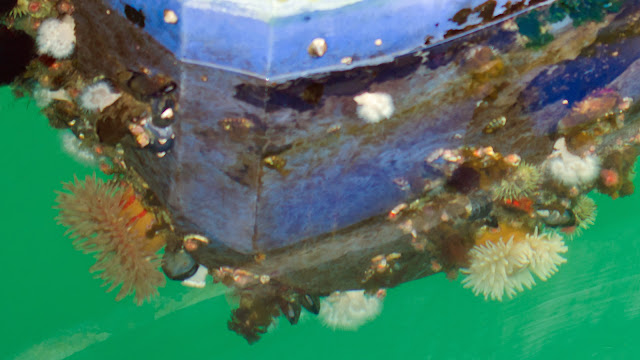I found myself yesterday evening at the entrance to
Garry Point Park, on the southwest corner of Lulu Island. The shoreline was crowded with people on logs, on chairs, on benches, on rocks, apparently all there to watch the sunset. So was I, but I walked around the shore to the westernmost point, where
Scotch Pond emerges to Georgia Strait.
From the south side of the point, and with my back to the sun, the sky was just beginning to take on a pink hue; the water was still blue.
(I'm posting the photos in chronological order to show how the light changes.)
 |
| Entering the south arm of the Fraser River, heading for the docks in Steveston. 7:55 PM. |
 |
| Goofing around with Picasa, and a photo that was too grey, I ended up with this: the tide coming in, swamping beach grasses and rearranging driftwood. Some of the pink hue stayed in. |
When I turned to face west, the colours changed; everything was orange or black.
 |
| One of the many photographers already set up waiting for the magic moment. |
The camera sees more orange than I do. My eyes are more flexible; I can squint into the too-bright light, without it affecting the whole scene.
 |
| From the outlet of Scotch Pond, looking directly west. There's enough reflected light from the slough for some of the green to show up. |
All those poles! A few, farther out, are light beacons, but the rest are rotting pilings. In 1899, a cannery was built here (the
Scottish Canadian Cannery, which gives its name to Scotch Pond). Rather than build on solid ground, the owners put it, with the workers' housing and net racks, all out on pilings on the tide flats, a good quarter of a mile outside the dike. It was still occupied as housing for Japanese families until 1942. The buildings have been gone for over a half century now, but the pilings remain, serving as perches for gulls and cormorants. There are two in this photo, or are those eagles?
 |
| From almost the same spot, looking north, over the Lulu Island tidal flats. What is that round thing? There's a row of them, all along this coastline. |
 |
| 10 minutes later. The sun is almost at eye level now. |
While I waited, I' prowled around, looking at plants; beach pea, blackberries, some orange and yellow asters, a few lupins, gone to seed already, and purple loosestrife, struggling to keep its foothold. And there, below the point, on the rocks, were a couple of fishermen with their poles. Backs to the sun, intent on their lines, they stood almost immobile until the lines jerked; then they reeled in their catch and dropped it in a mesh bag at their feet in the water.
 |
| Peamouth chub, about 6 inches long. Everything is blue, because my back is to the sun. |
These shallow bays are usually productive because when the tidal current is strong, most residential fish hide in them. Next time when fishing at Garry Point Park, instead of chucking a large chunk of worms into the fast water, try fishing close to the rocks with a float. Peamouth chub and some incredibly large northern pikeminnow usually rest by the rocks waiting for you to feed them. (From Fishing with Rod.)
These are small fish, not especially good eating, but plentiful and easy to catch. They are a freshwater fish, but also live in brackish waters, such as this slough. While I watched the two fishermen caught a half-dozen fish, all small.
 |
| 20 to 9. The sun is still there. A couple of kayakers head back inland, in an orange sea. |
 |
| 8:45. Just about sunset. The fishermen are still at work; those are their poles, angling across the slough. |
Another photographer, waiting with his tripod and zoom lens on the high ground, told me that the best time to catch the sunset is about 10 minutes after the sun has dropped past the horizon. All the sky glows, he said. I should wait for it.
But the mosquitoes had found me, and they were vicious. I was slapping my head, my ankles, my ears, my wrists, my ankles again, my neck ... Too much; I turned off the camera, snapped the lens cap on, and hurried away.
(The mosquitoes followed me, and got their fill. I lost my glasses on the way across the park and had to look for them in the dark, to the great delight of the whining horde.)
A
Skywatch post


















































